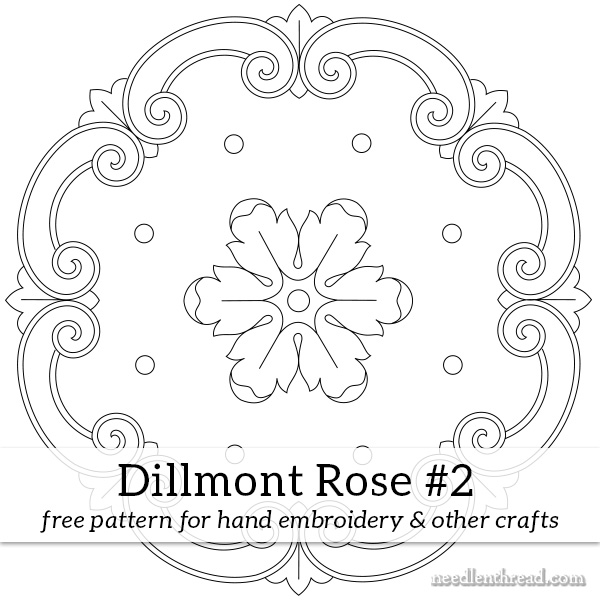Happy Monday!
To get your creative juices flowing for the week, here’s a cleaned up version of another Therese Dillmont design! This one is similar in some ways (we’ll talk about those below) to the Dillmont Rose I shared with you a few weeks ago, though a little simpler.
The design was originally intended as an embroidery design. It is from Dillmont book on Colbert embroidery, which you can read about here. It would also make a wonderful design for quilting and for crafts like paper crafts and card making.
Let’s chat a little bit about Colbert embroidery, to clarify some ways this design could be used for that style of needlework.

Colbert embroidery is a style of embroidery that incorporates somewhat simple, open designs that are usually fairly bold. The designs are outlined in a bold stitch – like a stem stitch worked in perle cotton or something similar. The type of thread and its weight, though, depends a lot on the size of your design and the type of fabric you’re using.
In both of the Dillmont patterns (today’s and this one), then, the line parts of the design would be stitched in a line stitch of some sort, and then all the open space in the backgrounds would be filled with colorful geometric patterns, usually based on counting.
Colbert designs as presented by Dillmont in her book on Colbert embroidery, which I wrote about here, are meant to be somewhat large. The designs she offers in the book are supposed to be either enlarged, or, in the case of these two, repeated to create the whole pattern.
The patterns would make excellent cushion designs, but they’d also work equally well for table toppers, runners, placemats, and so forth. And I think they’d make neat quilt squares, if they were embroidered in Colbert style and then incorporated in a quilt pieces from fabrics in the same color scheme as the embroidery.
In the article about Dillmont’s book, I drew a little bit of a connection between Colbert embroidery and Wessex stitchery as presented in this book. The concepts presented in both books, combined, would work well together.
To use the design in the PDF below in Colbert style embroidery, as printed at 7″, you’d have to use a very fine ground linen and fine threads, approaching the whole thing as more of a miniature design.
But you could enlarge the design to a standard 14″ cushion size, for example, and work it in bold lines with bold threads and bold background designs.
Other Ideas
Both Dillmont patterns are perfect springboards for other embroidery ideas. Goldwork, goldwork and blackwork combined, silk shading, crewel embroidery, whitework with pulled or drawn thread areas – all of these would work well on both designs.
Additionally, they’d works as a nice quilting pattern or appliqué design for quilting.
Free Embroidery Pattern: Dillmont Rose #2
Here’s the PDF for the design. It will print at approximately 7″ if you choose “no scaling” or “100%” on your printer options. If you want to enlarge it, you can do so easily on a copy machine.
Dillmont Rose #2 Hand Embroidery Pattern (PDF)
Looking for More?
If you’re looking for more hand embroidery patterns, you’ll find a slew of free designs to stitch right here on Needle ‘n Thread.
If you’re looking for stitches to stitch them with, why not take a browse through my how-to videosand stitch dictionary, or my Stitch Fun! series here on Needle ‘n Thread?







Dear Mary
The dillmont rose is a lovely pattern and could be made into many things as you have pointed out. Would also make a lovely design on clothes or a handbag even. Thanks for sharing the free pattern with us and for the history of Colbert embroidery.
Regards Anita Simmance
I was able to get Therese Dillmont’s Complete Encyclopedia of Needlework Kindle edition free. There is a Kindle app for PC’s too. I have it on both devices.
You can also get a dead tree copy used for $0.80 plus shipping.
Thank you again for introducing a new form of embroidery, to me! I love the designs and look forward to incorporating it into a project.
I love these old patterns, thanks so much for cleaning them up!
Dear Mary,
I have just “rediscovered” Crewel work. I also starte embroidery work as a young girl…was ultimately too impatient with counted cross stitch.
I am enjoying finding the webpages such as yours. Thanks so much….
Thank you Mary! I always learn so much from you.